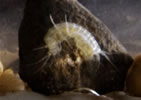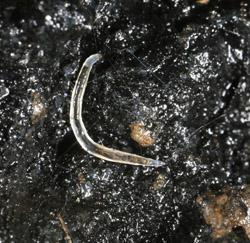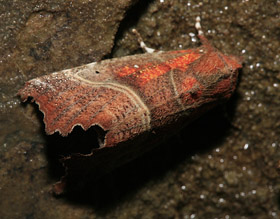Insects belong to the Class Insecta in the Phylum Arthropoda. There are many cave species in this group including some that are possibly troglobitic in Britain.
COLLEMBOLA (SPRINGTAILS)
The springtails are an ancient group of arthropods, similar forms have been found as fossils that are around 400 million years old. They are wingless ground dwelling insects that require high humidity. Many species have been recorded from the caves of northern England. They are called springtails due to their ability to leap about with the aid of a trigger or ‘spring’. Soil and underground species appear to have evolved a smaller spring, shorter legs and antennae, a higher fat content, reduction in eyes and loss of pigment. They feed on fungal mycelia, bacteria, decomposing plant and animal material. Not all springtails leap - some walk about on the water surface as if they are grazing. Their predators include pseudoscorpions and spiders, and in spite of their small size they can carry even smaller parasites such as nematode worms.
Springtails are most easily found on the surface of pools, some are so small (1mm) they will look like specks of white dust to begin with, but if you observe them for perhaps a minute one might leap a couple of inches – enough to convince you that it is actually alive. They are so light and small they can move about on top of the surface film of the water. The best places to look are still pools and damp mud banks.
The springtails Oligaphorura (=Onychiurus) schoetti (recorded from Ingleborough Cave, Lost Johns, Magnetometer Pot, Dale Barn, Pikedaw Calamine, Scoska) and Onychiurus dunarius (Crag Foot Mine, Warton) have not been recorded outside caves and mines in Britain and are thought to be possible troglobites within the country. Onychiurus ambulans has been recorded in caves of northern England. The Onychiuridae are blind and cannot jump, if threatened they rely on their defense glands (pseudocelli).
|
Troglobitic springtail Oligaphorura schoetti, Scoska cave |
Folsomia sp. are found near the entrance or where the surface is not far above. They can leap a short distance (c 1cm). Folsomia candida is found around the world and can survive underwater where the oxygen levels are low.
Deeper underground the white, rod shaped, sluggish Oligaphorura schoetti (1.7mm) might be seen on pool surfaces with the more active Isotoma sp.. Oligaphorura schoetti is a true troglophile and all records are from caves where it is quite common.
The smaller pink, globular, jumping Arrhopalites pymaes is often found on pool surfaces but not with O. schoetti. Almost all the UK records are from caves.
The grey brown Pariosotoma notabilis (1.4mm) is found deeper underground.
Schaefferia emucronata is common in caves in the UK (although the taxonomy of the genus and group are still unclear).
Tomocera minor (a relatively large 4.5mm) is common on mud banks and feeds on fungi. It lives in the soil but moves downwards during cold weather.
DIPTERA (TWO WINGED FLIES)
Diptera is an Order, their hind wings are modified into a pair of balancing organs called halteres. Many examples of Diptera are found in caves but most are visitors. The flies are often found in the same place year after year, and the Families represented in caves are described below.
There are two major groups or sub-orders: The Nematocera and the Brachycera.
SUB ORDER NEMATOCERA ‘thread horns’ are recognized by their elongated bodies and feathery antennae as represented by mosquitoes, gnats, midges and crane flies. Many of these swarm.
Family MYCETOPHILIDAE or Fungus gnats (their larvae feed on fungi). They are very delicate insects with long, slender antennae and long legs, especially the back ones.
Speolepta leptogaster is well represented in northern caves, some consider this species a troglobite as the larvae has not been found outside of cave-like habitats. The adult looks like an olive-brown miniature crane fly with long legs. The yellow headed translucent larvae (14mm) live in a web of thin threads (looks a bit like a sheet spiders web), and probably live on bacteria and fungi. The tangled mass of threads may be to keep the insect from touching the walls, becoming wet and then falling prey to fungi, although it may be to trap fungi and other organic material as the larvae eats the web and anything in it. You are most likely to see the fine small strands of the web against the roof or wall, sometimes with a larvae moving along the web. The adult is rarely seen as it makes its short flights from point to point but this may be explained by the fact it does not live very long. They can be seen in many caves including Borrins Moor Cave, Gaping Ghyll, Old Ing Cave, Rowten Pot, Scoska Cave, Sell Gill Hole.
|
Speolepta leptogaster larva, Yordas Cave |
Family SCIARIDAE Sciarid flies (dark winged fungus gnats) e.g. Bradysia sp have a black body and smokey wings (male), the adults are much more common than larvae (unlike Speolepta). Little is known about these flies. The adults (3mm) have large eyes and are a bit like a mosquito with relatively long legs and wings, beaded antennae and are weak flyers. The black headed, 12 segmented, white semi-transparent larvae (6mm), spins threads for a cocoon and may make a simple web. The larvae feed on fungi and the adults feed on decaying plant and animal material. There are many recordings from Yorkshire e.g. Marble Steps, Ingleborough Cave, Gaping Ghyll, Yordas Cave. The remains of the adult are often seen covered in fungi.
Family TRICHOCERIDAE Crane Flies. The Winter gnat or crane fly Trichocera maculipennis (8mm) can be found quite deep underground in large cave systems and has been recorded from Dow cave, Mongo Gill and Pikedaw Calamine Caverns. The adult is widely distributed but rarely seen, the larvae are attracted to baits such as rotting meat. It looks like a very small, delicate crane fly.
Other Craneflies visit the threshold in summer; they do not feed as adults. The crane fly Limonia nubeculosa is often found in cave thresholds as a summer visitor – it rests with its speckled brown wings covering its abdomen unlike many crane flies. Outside it is found all year round. There are often many in the threshold of caves and it has been recorded from Goyden Pot, Sleets Gill, Scoska and caves around the Morecambe Bay.
|
Crane fly Limonia nubeculosa Manchester Hole |
Family SIMULLIDAE black flies
Blackfly (Simulium sp.) larvae are washed in by surface streams. They can be seen anchored to the rocks in the fast flowing streams trying to catch debris as it floats past.
Famly CHIRONOMIDAE includes the non-biting midges e.g. Chiromomid blood worm larvae.
Family CULICIDAE e.g. Common Mosquito Culex pipiens. Those in caves are mostly inseminated females overwintering in the thresholds. They leave the cave in spring for a blood meal, usually from a bird (not from humans). There are several generations a year. Female Culex pipiens with its blood sucking proboscis, Short Drop Cave.
SUB ORDER BRACHYCERA have a more roundly proportioned body and much shorter antennae.
Family HELEOMYZIDAE
One of the Marsh flies Heleomyza captiosa is a common visitor to the threshold – they arrive in autumn and remain until starvation or fungal attack. Maybe they settle somewhere dry in the dark zone in winter and get caught out as air current reverses in summer with the corresponding rise in humidity and condensation. In some caves they are present all year so it is unclear why they visit the caves. This dampness is ideal for the fungi to attack them. The small adults are found all year round in the cave, often in shaded areas near rotting matter, but the reason why is not clear. It is probable that many of the recordings of H. serrata are actually H. captiosa, they are identical to the naked eye. The larvae feed on sheep droppings and so they are sometimes known as dungflies (true dung flies are in the Scathophagidae family). The adult Heleomyzidae flies are predators on other flies. Heleomyzids have been recorded from many caves in the region. Scoliocentra sp., another Heleomyzid, is also found in the threshold.
|
Marsh fly Heleomyza captiosa, Dow Cave |
FAMILY PHORIDAE Scuttle or Coffin flies e.g. Tripleba antricola has been recorded in Gill Rigg I, Ribblesdale. These run about and are reluctant to fly. They get their name from the scuttling behaviour and seeming reluctance to fly, and the close association with corpses.
A variety of other Diptera fly species have been recorded from caves in northern England, including species in the families Sphaeroceridae (e.g. Limosina racovitzi which could be a troglobite) and Calliphoridae from the Sub Order Brachycera and Psychodidae from the Sub Order Nematocera.
ORDERS EPHEMEROPTERA (Mayfly), PLECOPTERA (Stonefly), TRICHOPTERA (Caddis Fly)
These Orders generally have two pairs of wings although the hind pair is sometimes much reduced in size or missing as in some mayfly. Mayflies, stoneflies and caddis flies have nymphs that live in streams, some have several generations an year while some larger species have nymphs that live in the streams and rivers for a few years before becoming an adult fly. The adults may only live for a few days. Their nymphs are washed into caves from the surface and a variety of species can be found in the streams of the caves, sometimes a considerable way underground.
MAYFLY e.g. Baetis and Ecdyonorus are common in allogenic cave streams. Adult mayflies hold their wings upright at rest and have two or three tails. The nymphs have three tails.
STONEFLY Dinocras cephalotes is the most frequently recorded, others are Nemouras cambrica and Leuctra sp. Adults hold their wings flat along the back, or in the Leutricidae family (needle flies), rolled around the abdomen. The larva have two long tails, the adults look like a winged larva although some species lose the tails.
CADDIS FLY Plectrocnemia conspersa and P. geniculata larvae spin nets in the stream to capture prey. They can make a number of different types of net depending on the water conditions. The variable net-spinning behaviour enables the caddis population to exploit a wide range of prey and microhabitats. If a sufficient food supply is washed in by the stream these nymphs and larvae can continue to survive underground but as soon as they metamorphose into winged adults they will die as the adult stages often rely on plants for feeding. They have been seen in the streams of Dow Cave, Borrins Moor, Robinsons Pot and Ingleborough Cave. Adult Philopotamus montanus, yellow spotted sedge, are not uncommon in caves.
Adults of the large buff coloured caddisfly Stenophylax permistus use the cave threshold as a resting stage for part of the summer (diapause) – a few recordings are from mine levels. Photograph from Scoska Cave.
ORDER LEPIDOPTERATA (BUTTERFLIES AND MOTHS)
Two species of moth commonly overwinter in the thresholds of caves (they do move around the cave during this time). The Herald moth (Scoliopteryx libatrix) is common in the dry parts of many cave entrances (e.g. Scoska, Yordas, Pool Sink) and is often found in the dark zone beaded in moisture, staying up to 10 months underground – it is unlikely this is all hibernation so why does it spend all this time in the cave? It may be for the ovaries to develop. It keeps its head pointing away from the light. The caterpillar eats willow and poplar.
|
Herald Moth Scoliopteryx libatrix, Hale Moss Cave |
The Tissue moth (Triphosa dubitata) settles closer to the entrance and lower down the wall than the Herald moth. The caterpillar eats buckthorn and blackthorn. The Tissue Moth has been recorded from Scoska and other caves. The populations of these two moths in Scoska cave have been studied for a number of years.
COLEOPTERA (BEETLES)
Several species of beetle are cavernicoles. A variety of species can potentially be found in the threshold of caves but the ones most likely to be found deeper underground are members of the ground beetle (Carabidae) and rove beetle (Staphylinidae) families (there are over 980 species of rove beetle recorded in the UK).
A number of ground beetles, Carabidae, have been recorded but none are frequent. They include Trechus fulvus and Bembidion guttala.
The rove beetles, Staphylinidae, are more common and include the Devils Coach Horse Ochthephilus (=Ancyrophorus) aureus (Gaping Ghyll, Ingleborough Cave, Providence Pot, Sleets Gill), Quedius mesomelinus (Gaping Ghyll, Stump Cross Cavern) and Lesteva pubescens (Gaping Ghyll, Goyden Pot, Magnetometer Pot, White Scar Cave). They have been recorded from a variety of caves, wet and dry. These latter two species are generally regarded as troglophilic. Rove beetles are generalist predators on e.g. fungus gnat larvae, but also feed on dead organic matter.
|
Rove beetle Staphylinidae in Albert Cave |
Choleva augusta and C. glauca have been found in the threshold in summer diapause. Other beetle species found in the threshold include members of the families Cantharidae and Helodiidae.
Aquatic beetles have also been recorded from wet caves, washed in from the surface, including Agabus guttatus and Hydroporus sp. These beetles can all be found in streams and pools on the surface. The diving beetle Agabus guttatus is recorded from several caves across the region and seems to be able to survive well underground. Agabus guttatus in Long Churn.
HEMIPTERA (BUGS)
Aquatic Bugs have also been recorded from cave streams and as with the nymphs described above have been washed in from the surface. The Water Cricket Velia caprai (8mm) has been recorded from a variety of caves including Browgill Cave, Goyden Pot, Yordas Cave and Scoska Cave. It is distasteful to predatory fish, engages in kleptoparasitism (takes or shares prey taken by other Water Crickets), and can travel at twice its normal speed by spitting saliva on the water surface. It has a complex life cycle and overwinters in a number of different states (mature, immature, 5th instar larvae and eggs. The adults are found on the water surface but also quite happily climb out onto the walls. The macropterous (large winged) state is rare, probably because when this bug needs to find a new habitat it prefers walking as a mode of dispersal.
|
Water Cricket, Velia capriai Ingleborough Cave |
OTHER INSECTS
Fleas are common on bats. They are small wingless parasites noted for their ability to leap.
There have been no records of the THYSANURA (Three Tailed Bristletails) or DIPLURA (Two tailed Bristletails) in the northern caves.
|


.jpg)

.jpg)
.jpg)

.jpg)
.jpg)